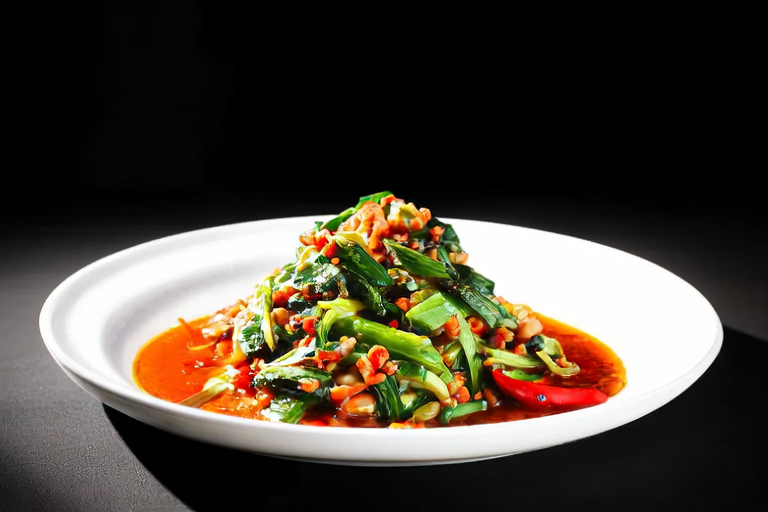- Introduction to Stir-Fried Vegetable Delight
Stir-frying is an essential cooking technique in Chinese cuisine, and it is often regarded as one of the most efficient ways to prepare vegetables. This method not only preserves the nutrients and flavors of the ingredients but also allows for a wide range of flavor combinations. In this article, we will explore how to create a delicious stir-fried vegetable dish that is both nutritious and flavorful.
The stir-fried vegetable delight we’re about to prepare is a harmonious blend of various vegetables, each contributing its unique texture and taste to the dish. The key to a successful stir-fry lies in the choice of vegetables, the quality of the ingredients, and the precise timing of each step. We’ll delve into these aspects in detail to ensure you can recreate this dish with ease at home.
- Selecting the Right Vegetables
Choosing the right vegetables is crucial for the success of your stir-fried vegetable delight. The vegetables should be fresh, vibrant, and in season. Here are some recommended vegetables that work well together:
- Bell Peppers: These add color and sweetness to the dish. Choose a mix of red, yellow, and green peppers for a visually appealing result.
- Zucchini: Adds a mild, slightly sweet flavor and a tender texture.
- Cauliflower: Provides a crunchy element and absorbs the flavors of the sauce beautifully.
- Bok Choy: Offers a delicate, slightly bitter taste and a crisp texture.
- Carrots: Adds natural sweetness and a satisfying crunch.
It’s important to note that the vegetables should be cut into similar-sized pieces to ensure even cooking. Additionally, blanching some vegetables like bok choy and carrots can help reduce cooking time during the stir-fry process.
- Preparing the Ingredients
Before starting the cooking process, it’s essential to prepare all the ingredients thoroughly. This includes washing, trimming, and cutting the vegetables into appropriate sizes. For this recipe, you’ll need:
- Vegetable Oil: Use a high-smoke-point oil such as peanut or sunflower oil.
- Ginger and Garlic: These add depth and aroma to the dish.
- Soy Sauce: A staple in Asian cooking, providing saltiness and umami.
- Oyster Sauce: Enhances the savory flavor of the dish.
- Sugar: Balances the flavors and adds a touch of sweetness.
- Chili Flakes: Adds a spicy kick (optional).
- Salt: To taste.
Once all the ingredients are prepared, you can proceed to the cooking stage. It’s important to have everything ready before you start stir-frying to avoid any delays in the cooking process.
- The Cooking Process
The stir-frying process is quick and requires attention to detail. Follow these steps carefully to achieve the best results:
- Heat the Wok: Preheat a wok or large frying pan over high heat. Add a tablespoon of vegetable oil and swirl it around the pan to coat the surface evenly.
- Stir-Fry the Aromatics: Once the oil is hot, add minced ginger and garlic. Stir-fry for about 30 seconds until fragrant. Be careful not to burn them, as this can make the dish bitter.
- Add the Vegetables: Start by adding harder vegetables like carrots and cauliflower. Stir-fry for about 2-3 minutes until they begin to soften. Then add softer vegetables like bell peppers and zucchini. Continue stir-frying for another 2-3 minutes until all vegetables are just tender-crisp.
- Season the Dish: Pour in soy sauce, oyster sauce, and a pinch of sugar. Stir-fry for another minute to allow the flavors to meld together. Taste and adjust seasoning with salt and chili flakes if desired.
- Finish the Dish: Add bok choy last, as it cooks quickly. Stir-fry for just 1-2 minutes until it wilts. Remove from heat immediately to prevent overcooking.
During the stir-frying process, use a spatula to continuously toss the vegetables, ensuring even cooking and preventing them from sticking to the bottom of the pan. The goal is to achieve a perfect balance of textures and flavors, where each vegetable retains its individual characteristics while blending harmoniously with the others.
- Serving Suggestions
The stir-fried vegetable delight can be served as a standalone dish or paired with other components to create a more complete meal. Here are some serving suggestions:
- Rice or Noodles: Serve the stir-fried vegetables over steamed rice or noodles for a hearty meal.
- Dumplings or Spring Rolls: Pair the dish with dumplings or spring rolls for added variety.
- Salad: Include a side salad with a light vinaigrette to balance the richness of the stir-fry.
The versatility of this dish makes it suitable for various occasions, from everyday meals to special gatherings. You can also experiment with different combinations of vegetables and sauces to suit your taste preferences.
- Health Benefits of Stir-Fried Vegetables
In addition to being delicious, stir-fried vegetables offer numerous health benefits. They are low in calories and rich in essential vitamins and minerals, making them an excellent choice for a healthy diet. Some specific benefits include:
- Vitamin C: Found in bell peppers and bok choy, vitamin C is a powerful antioxidant that supports immune function and skin health.
- Fiber: Vegetables like carrots and zucchini provide dietary fiber, which aids digestion and promotes heart health.
- Antioxidants: Many vegetables used in stir-fries contain antioxidants that help protect against cellular damage and reduce inflammation.
- Low in Fat: The cooking method minimizes the use of fat, making the dish a healthier option compared to deep-fried alternatives.
By incorporating a variety of vegetables into your diet, you can enjoy a wide range of nutritional benefits while savoring the delightful flavors of stir-fried dishes.
- Tips for Perfecting Your Stir-Fried Vegetable Delight
To help you achieve the best possible results when preparing your stir-fried vegetable delight, here are some additional tips:
- Use a Wok: If possible, use a traditional wok. Its curved shape allows for efficient heat distribution and easy tossing of ingredients.
- Pre-soak Wooden Utensils: If using wooden utensils, soak them in water for a few minutes before cooking to prevent burning.
- Control the Heat: Keep the heat high throughout the stir-frying process to ensure the vegetables cook quickly and retain their crispness.
- Don’t Overcrowd the Pan: Adding too many vegetables at once can cause them to steam instead of stir-fry, leading to mushy results. Cook in batches if necessary.
- Rest the Dish: Allow the stir-fried vegetables to rest for a couple of minutes after removing from heat. This helps the flavors meld together and the vegetables absorb the sauce.
By following these tips, you can elevate your stir-fried vegetable delight to new heights and impress your family and friends with your culinary skills.
- Conclusion
Stir-fried vegetable delight is a versatile and nutritious dish that can be enjoyed by people of all ages. With the right selection of vegetables, proper preparation, and precise cooking techniques, you can create a dish that is both visually appealing and delectable. Whether you’re a seasoned chef or a beginner in the kitchen, this recipe offers a wonderful opportunity to explore the world of Chinese cuisine and appreciate the art of stir-frying.
We hope you enjoy preparing and savoring this dish as much as we do. Happy cooking!


